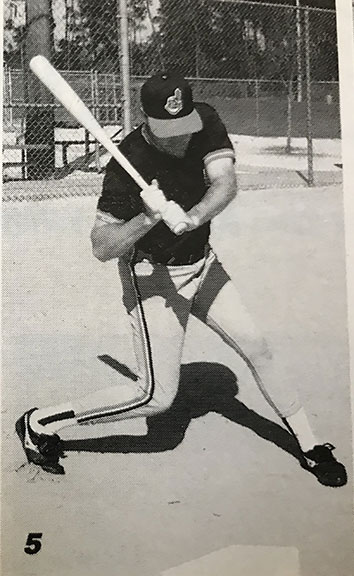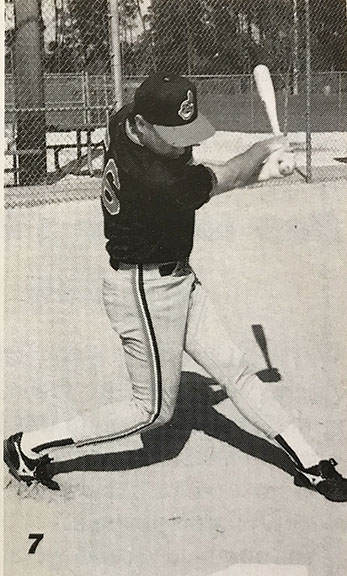Baseball: 7 steps to good hitting
Throughout the year, Coach & Athletic Director will go back 25 years to share some of our best articles from 1994. The publication, formerly Scholastic Coach magazine, is closing in on 89 years of production. What better way to celebrate our longevity in the team sports industry than to show what we’ve done and where we’ve been.
This article — “7 steps to good hitting” — was written by Jim Gabella while he was an instructor with the Cleveland Indians. Today, Gabella is a scout for the San Francisco Giants.
The accompanying photographs reveal what the best hitters in the world do throughout their swing.Stance (photo 1)
 This, we believe, is one of the most overrated and overcoached phases of hitting. There are all kinds of stances in baseball. They range from Carl Yastrzemski, who held his hands high over his head, to Pete Rose, who crouched, to Julio Franco, who held his bat above his head and parallel to the ground.
This, we believe, is one of the most overrated and overcoached phases of hitting. There are all kinds of stances in baseball. They range from Carl Yastrzemski, who held his hands high over his head, to Pete Rose, who crouched, to Julio Franco, who held his bat above his head and parallel to the ground.
Although every hitter has his own stance, the accomplished hitters have three things in common:
- They keep their head and eyes level with the pitcher. Any cocking of the head will tilt the eyes and make it difficult to track the pitch.
- All good hitters have some kind of rhythm and movement in their swing. This serves as a timing mechanism and helps alleviate tension in the stance.
- Since the hitter’s hands will automatically tighten up when they start to swing, it’s essential to keep the hands loose in the stance. Remember: Tight muscles are slow muscles; loose muscles are quick muscles.
Stride (photo 2)
 This enables the hitter to go from his stance into the power position. The hitter takes a short, low step toward the pitcher as his hands move back. Both of these movements must be done simultaneously as the pitcher’s arm comes forward.
This enables the hitter to go from his stance into the power position. The hitter takes a short, low step toward the pitcher as his hands move back. Both of these movements must be done simultaneously as the pitcher’s arm comes forward.
All good major league hitters have similarities in their strides:
- They keep their head and eyes level.
- Their hands go back into position over the back leg at shoulder level.
Remember, one of the hardest things to do in any sport is to start from a dead standstill. The stride helps the hitter get started and takes him into the power position.
Power Position (photo 3)
This is the point at which the hitter’s front foot touches down after striding. It’s extremely critical to the development of a mechanically sound swing.
 All consistent hitters have similarities in the power position:
All consistent hitters have similarities in the power position:
- The front arm is flexed with the elbow pointing down. This enables the hitter to have a short swing. A locked front elbow produces a swinging action that results in poor, inconsistent contact.
- The top hand is closer to the pitcher than the bottom hand, called “cocking” the bat. This helps keep the front elbow flexed and helps the bat take the shortest route to the ball.
- The bay stays up, as if someone is pulling up on the back of the hitter’s pants. This helps put the weight over the balls of the feet, enabling the hitter to stay balanced.
- The knees are flexed and the eyes, shoulders and hips level, further ensuring the hitter’s balance. Note that the front foot is closed, pointing straight at the plate.
This is the most athletic position an athlete can be in. It’s equivalent to the defensive position in basketball, or the serve-reception position in tennis.
Stop-action photos show that all successful hitters are in a triangulated orientation from the top of their bat to the bottom of their feet. This is the power position that good hitters assume before initiating their swing.
Initiation with lower half of body (photo 4)
Contrary to popular belief, it’s the lower half of the body — not the hands — that initiates the swing. The back hip sends a message down the back leg, which then starts to pivot on the ball of the foot.
 The impulse and the movement cannot be seen with the naked eye, but slow-motion photography shows that the back leg starts while the hands are still back in a cocked position.
The impulse and the movement cannot be seen with the naked eye, but slow-motion photography shows that the back leg starts while the hands are still back in a cocked position.
» ALSO SEE: Strategies for coaching your outfielders
Since the largest, strongest muscles of the body are in the buttocks and thighs, it’s essential to use them to generate bat speed and power. The hitter who starts his swing with his hands will find it almost impossible to use the lower half of the body, thus losing most of his power.
He would also become very susceptible to off-speed pitches, as the hands have already committed to the ball and the hitter has nothing left to swing with.
Hands to ball and rotate (photo 5)
 Once the hitter has started the initial approach with the back leg, he does two things:
Once the hitter has started the initial approach with the back leg, he does two things:
First, he take his hands directly to the ball, keeping the barrel of the bat above the hands. Anytime the barrel drops below the hands before contact, it decreases the chances of making consistent contact. Keeping the barrel above the hands also enables the hitter to take the shortest route to the ball, creating a short swing and more contact.
Second, as the hitter is taking his hands to the ball, he must aggressively rotate on the balls of his feet. The rotation action generates power through the lower body.
Contact (photo 6)
All good hitters do four essential things at contact:
 Head down. The head comes down at contact as the hitter tracks the ball. At contact, his chin almost contacts the back shoulder.
Head down. The head comes down at contact as the hitter tracks the ball. At contact, his chin almost contacts the back shoulder.- Palm up, palm down. At contact, the hands are in a palm up (bottom hand), palm down (top hand) position. Any other position would cause poor contact. If, for instance, the top hand rolls over prematurely at contact, the hitter would top the ball, thus hitting weak ground balls.
- Stiff front leg. Hitting against a bent (rather than straight) leg would cause a loss of valuable power, as the hitter would use mostly his upper body in the swing.
- Back leg forms an ‘L.’ This shows that the hitter is using the lower half of his body and, most importantly, getting his hips and thighs into the swing. At contact, the hitter is also slightly flexed. He doesn’t straighten out until the follow through
Note that the hitter does not “extend” his arms as many experts advocate, possibly because they do not understand that “extends” means straight out.
Check the hitter. He’s exhibiting the classic good form: Front arm slightly flexed, back arm flexed at the elbow, and contact being established off the front heel.
Follow through (photo 7)
 The key element is the top hand rolling over with the hitter still behind the stiff front leg and the L-shaped back leg.
The key element is the top hand rolling over with the hitter still behind the stiff front leg and the L-shaped back leg.
One common question: Should the hitter let go of his top hand in his follow through? This neither helps nor hinders the hitter, as the ball has already left the bat and nothing more can be done.
It’s OK if the hitter feels comfortable letting go of his top hand. That’s as long as he doesn’t let go at contact, losing power. The follow through completes the swing, but it serves a purpose: An awkward follow through often indicates a flaw in the swing.



